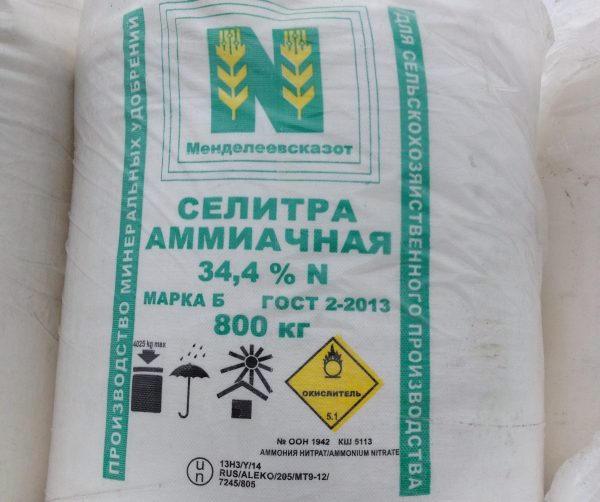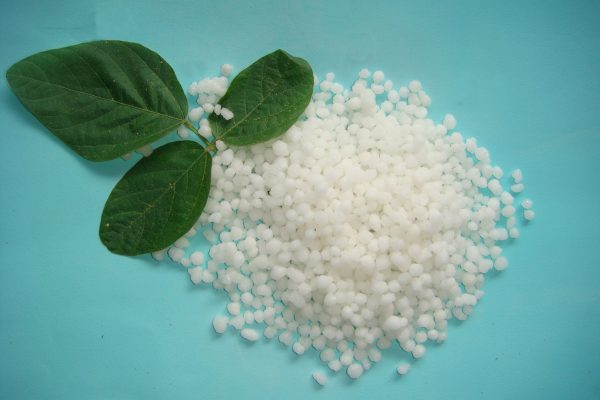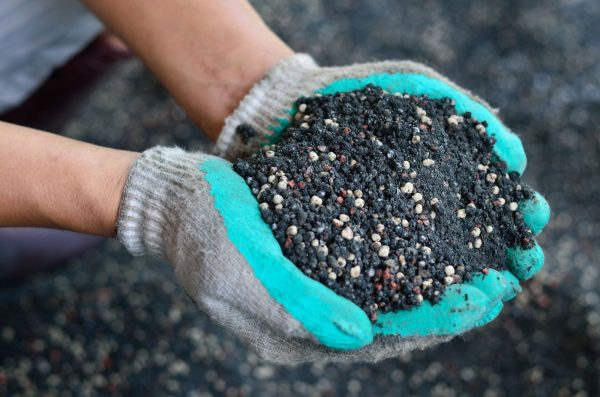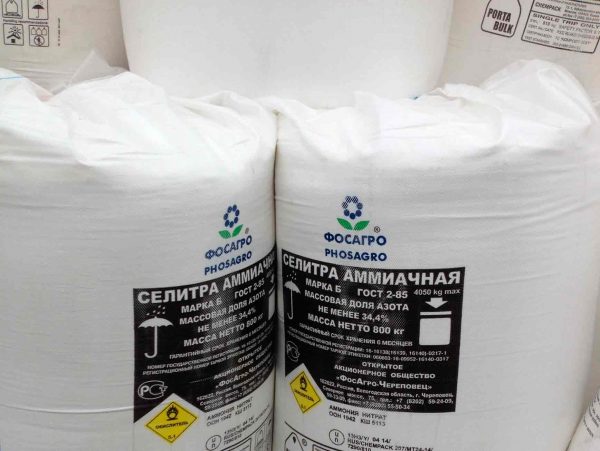Fertilizer ammonium nitrate: instructions for use and storage of the substance
Content
Fertilizers
Ammonium nitrate (ammonium nitrate) is a granular substance of white with a grayish tint, mostly consisting of nitrogen (up to 35%) - a substance that actively stimulates the growth of crops. The high efficiency of nitrate is due to the presence of sulfur (3-14%) in its composition, which increases the absorption of nitrogen by plants. Fertilizer applied in early spring is an excellent building material for plants at the start of their development.
Saltpeter, used as a fertilizer, is almost always produced with the addition of various trace elements. The use of these additives is due to the characteristics and needs of the soil in certain climatic zones. There are several types of nitrate produced by industry:
- Simple ammonia. This variety was one of the first to be developed. Its main task is to provide crops with concentrated nitrogen at the initial stage of growth. Top dressing is successfully used in the agro-industrial economy of many countries as a starting fertilizer, as well as an alternative to carbamide (urea).
- Ammonia grade "B". It is subdivided into first and second grade. Its main application is the cultivation of seedlings and indoor plants, which in limited natural conditions are especially in need of nitrogen. Produced in a small, convenient package, well stored.
- Potash. In addition to nitrogen, it also contains potassium. Ideal for pre-sowing soil application in spring, as well as top dressing during active vegetation: budding, flowering, fruit set. It helps to improve the taste of the crop, therefore it is widely used by gardeners for fruit trees, vegetables, especially tomatoes.
- Limestone. Produced mainly for the agro-industrial complex. Its composition is additionally enriched with magnesium, potassium and calcium. There are two types: simple and granular. Granules of the latter have increased strength - they do not cake during storage, are safe during transportation. Among the disadvantages, it can be noted that lime nitrate is processed with fuel oil, but thanks to the use of fuel oil, it is well absorbed and does not increase the acidity of the soil.
- Calcium. It is produced in granular and liquid form. Its main purpose is to feed crops in case of insufficient calcium concentration in the soil. Calcium deficiency leads to decay of the roots and cessation of growth, and after fertilization with calcium, plant growth is restored, the yield increases, the fruits last longer.
- Magnesium. It is used as an additional source of magnesium when growing vegetables and legumes.
- Sodium. This type of saltpeter can be used to fertilize any crops on all types of soils. She also found its application in the food industry in the processing of meat.
There is also porous saltpeter, but it is used only for the manufacture of explosives, and cannot be used as a fertilizer.
Video "Spring feeding of garlic with ammonium nitrate"
Recommendations for the use of ammonium nitrate for plant nutrition in the spring at their summer cottage.
How to apply
Ammonium nitrate, due to its high nitrogen content, is widely used both in agriculture and in individual gardening and horticulture. Despite the acidic environment, this nitrogen fertilizer has a neutral pH reaction, and therefore it can be used on almost all soils, including acidic ones. But, when applied to podzolic and acidic soils, simultaneously with nitrate, calcium carbonate must be added to the soil in a ratio of 0.75 g / 1 g of nitrate.
A distinctive feature of ammonium nitrate is its ability to act immediately, and at low temperatures, which is unusual for any other fertilizer. Therefore, the product can be applied in early spring, even when the snow has not completely melted. However, it is not recommended to carry out foliar treatment with nitrate, since the agent can cause serious burns to plants.
Nitrogen fertilization is quite effective when used on soils of intensive exploitation. It often happens that the same crops are grown on the site from year to year (crop rotation is disturbed), which subsequently leads to depletion of the soil, and the accumulation of pathogenic fungi in its upper layer. Such soil can be restored only with disinfectants and special preparations, including saltpeter.
Such fertilization of the soil with nitrate helps to strengthen the protective properties of plants, increases their resistance to fungal putrefactive infections. Introduced into the soil in spring, it protects vegetables and fruit crops from diseases throughout the season. Crystals of ammonium nitrate absorb moisture rather quickly, which is why the fertilizer often cakes - it turns into large lumps, which must be crushed before use. It is very important that the product has a crumbly structure. Otherwise, the lumps will dissolve for a long time and can cause serious damage to the soil.
Is it dangerous with nitrates
Ammonium nitrate consists of more than a third of nitric acid salts (nitrates), and 14% of sulfur, but this does not mean that the product is dangerous to human health. Nitrates are an essential element for plant nutrition, the only question is their quantity. For example, regular feeding of the soil with bird droppings or manure, due to their high nitrogen content, also contribute to the accumulation of nitrates in fruit and vegetable crops.
To avoid excessive formation of nitrates in the fruit, you just need to follow the recommended dosage when applying the product. It is important to stop using any fertilizer two weeks before harvest. In addition, plants such as melons, pumpkin, squash, cucumbers and squash have the ability to increase the accumulation of nitrates, so it is not recommended to fertilize them with ammonium nitrate.
Fertilization rates
Fertilizing with ammonium nitrate must be strictly observing the dosage indicated in the instructions for use:
- immediately before planting, it is recommended to use an aqueous solution, which is brought in to a depth of 10-12 cm;
- the loose method is suitable for fertilization in early spring, when the soil is still cold, since the assimilation of the product takes time;
- when planting seedlings, the recommended dose is 2-3 g per well, if fertilized with an aqueous solution, the concentration is 30-40 g / 10 l of water;
- the areas intended for planting root crops should be fertilized at the rate of 25-30 g of the product / 1 sq. m, if before the soil was not fed with anything, the dose can be increased to 50 g;
- fruit shrubs and trees are recommended to be fertilized around the trunk at a dosage of 15-18g / 1 sq. m, for the preparation of a liquid product, the norm is 25-30g / 10 l of water.
If you fertilize the soil and plants during the growing season, then the norms will be as follows:
- for root crops 5-7 g / sq. m - apply twice: before flowering and after the formation of the ovary;
- for vegetables 5-10 g / sq. m - granules are used for use, which are poured into depressions in the soil a couple of weeks after germination;
- for fruit bushes and trees 15-20 g / sq. m - it is recommended to fertilize with a dry agent once during the period of leaf appearance, the diluted composition is used for root application.
Storage of nitrate
Fertilizer is classified as an agricultural chemical. It contains substances that need special conditions to preserve their properties:
- the nitrogen contained in ammonium nitrate can evaporate, therefore, it is necessary to store the product in an airtight container without damage;
- ammonium salt (the main substance of the fertilizer) is explosive - at a temperature of 32.5 ° C and above it can explode, therefore, in hot weather, the product must be stored in a cool room with good ventilation;
- salt crystals easily absorb moisture - in order to preserve the free-flowing consistency of the product, it must be stored in a dry room, and special moisture-absorbing substances should be placed in bags with ammonium nitrate;
- in the room where the substance is located, it is forbidden to store flammable and other materials that can react: acids, oil products, coal, wood, sawdust, lubricants, and also you can not smoke and use lighting with an open flame;
- the distance from the folded packages to the walls should be at least 0.2 meters, and from the heat source 1.5 meters.
When storing in warehouses, the following requirements must be taken into account: standard packages weighing up to 50 kg can be stacked no more than 12 layers, and no more than 300 tons can be stored in one room. Fertilizer transportation is possible by any transport, except for aviation. Ammonium nitrate has no harmful effect on humans when inhaled, but it can cause severe skin irritation, dermatitis, especially when it comes into contact with wet skin. Therefore, it is recommended to work with fertilizer only with rubber gloves.
Video "Adding saltpeter to frozen-thawed soil"
Video review on the application of ammonium nitrate to the field using the No-Till Technology on frozen-thawed soil.








